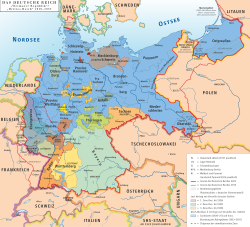Weimar Republic
German Reich Deutsches Reich | |||||||||
|---|---|---|---|---|---|---|---|---|---|
| 1918–1933 | |||||||||
| Motto: "Einigkeit und Recht und Freiheit" "Unity and Justice and Freedom" | |||||||||
| Anthem: | |||||||||
 Weimar Republic in 1930 | |||||||||
 German States in 1925 (Free State of Prussia with its provinces shown in blue) | |||||||||
| Capital | Berlin | ||||||||
| Official languages | German | ||||||||
| Common languages | Official: German Unofficial: | ||||||||
| Religion | 1925 census[1] 64.1% Protestant (Lutheran, Reformed, United) 32.4% Roman Catholic 0.9% Jewish 2.6% Other | ||||||||
| Demonym(s) | German | ||||||||
| Government | 1919–30 Federal semi-presidential constitutional republic 1930–33 De facto authoritarian presidential republic | ||||||||
| President | |||||||||
• 1919–25 | Friedrich Ebert | ||||||||
• 1925–33 | Paul von Hindenburg | ||||||||
| Chancellor | |||||||||
• 1919 (first) | Philipp Scheidemann | ||||||||
• 1933 (last) | Adolf Hitler | ||||||||
| Legislature | Bicameral | ||||||||
• State Council | Reichsrat | ||||||||
| Reichstag | |||||||||
| Historical era | Interwar period | ||||||||
• Established | 9 November 1918 | ||||||||
| 11 August 1919 | |||||||||
• Admitted to the League of Nations | 8 September 1926 | ||||||||
• Government by decree begins | 29 March 1930 | ||||||||
• Hitler appointed Chancellor | 30 January 1933 | ||||||||
| 27 February 1933 | |||||||||
| 23 March 1933 | |||||||||
| Area | |||||||||
• Total | 468,787 km2 (181,000 sq mi) | ||||||||
| 1925[2] | 1,933 km2 (746 sq mi) | ||||||||
| Population | |||||||||
• 1925[2] | 62,411,000 | ||||||||
| Currency |
| ||||||||
| |||||||||
The Weimar Republic is the name now used for the republic which governed Germany from 1918 to 1933.
Officially it was the German Reich (Deutsches Reich): (German: Weimarer Republik [ˈvaɪmaʁɐ ʁepuˈbliːk] (![]() listen)).
listen)).
It was also unofficially referred to as the German Republic (Deutsche Republik).
Origin
[change | change source]After the German Empire was defeated in World War I, Germany became a republic, but it was still called "Deutsches Reich" (German Empire).
Today it is called the Weimar Republic and this period is called the Weimar period, because the constitution was made in the city of Weimar.
Beginning
[change | change source]On November 9, 1918, the Republic was proclaimed by Philipp Scheidemann at the Reichstag building in Berlin and two hours later a socialist republic was proclaimed around the corner at the Berlin Castle by Karl Liebknecht.
The Emperor, or Kaiser, Wilhelm II, went into exile in the Netherlands. The new Republic was declared even before end of World War I on 11 November 1918.The fighting in World War I stopped on 11 November 1918 when the Armistice of Compiegne was signed.
Problems
[change | change source]The Weimar Republic had a lot of problems. The Treaty of Versailles made things very difficult for the economy. Inflation got completely out of hand. There were political problems because governments ruled only for a short time, not long enough to be able to make important decisions. There were a lot of radical right and left extremists, for example monarchists (people who wanted back the monarchy) and communists, who believed that all things, especially property, land and money, should be shared. Political parties had their own militias to fight each other.
One of the paramilitary organizations that arose after World War I was the German: Stahlhelm, Bund der Frontsoldaten meaning "Steel Helmet, League of Front Soldiers".[3] They operated as the armed branch of the national conservative German National People's Party (DNVP). they were placed at party gatherings in the position of armed security guards (Saalschutz). In 1935 they became part of the Nazi Party.[3]
Positives
[change | change source]The Weimar period is also known for its culture. Artists tried out modern ideas and used new things like film. The Bauhaus began in the 1920s.
End
[change | change source]The Weimar Republic came to an end on 23 March 1933, when Chancellor Adolf Hitler installed the Enabling Act, which established the Third Reich.
References
[change | change source]- ↑ Volume 6. Weimar Germany, 1918/19–1933 Population by Religious Denomination (1910–1939) Sozialgeschichtliches Arbeitsbuch, Volume III, Materialien zur Statistik des Deutschen Reiches 1914–1945, edited by Dietmar Petzina, Werner Abelshauser, and Anselm Faust. Munich: Verlag C.H. Beck, 1978, p. 31. Translation: Fred Reuss.
- ↑ "Das Deutsche Reich im Überblick". Wahlen in der Weimarer Republik. Retrieved 26 April 2007.
- ↑ 3.0 3.1 "The Steel Helmet/Association of Frontline Soldiers (Germany)". CRW Flags. Retrieved January 30, 2017.
Other websites
[change | change source]- The Constitution of the German Reich (Weimar constitution) of 11th August 1919, in full text Archived 2021-03-22 at the Wayback Machine
- PSM Data Bank
- historical Documents (in German)



